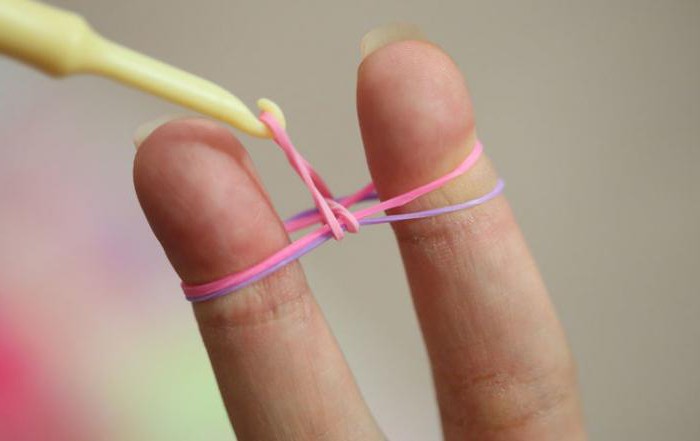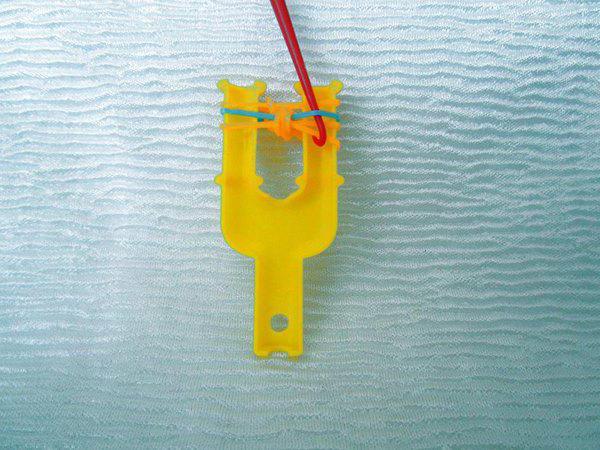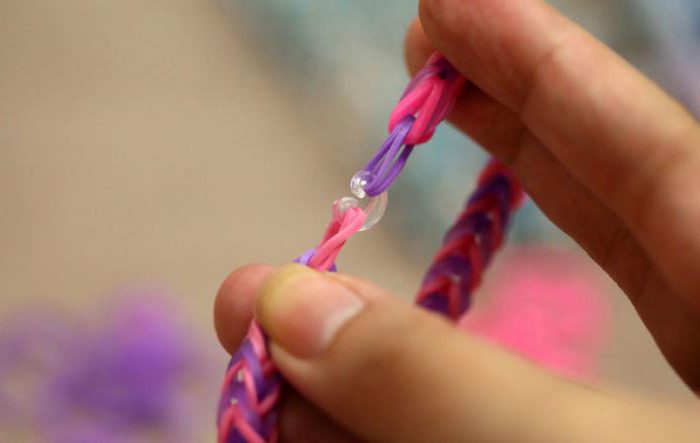How to weave bracelet "pavement" of rubber bands on the machine and on the fork
Bright and colorful, or sustained incalm tones of bracelets encircling their wrists, today can be seen not only on children's hands, but also in adults. Fashion for woven from rubber accessories was literally captured by most citizens of our country. For today there are more than hundred kinds of weaving bracelets, the "Sidewalk" bracelet is very popular among them. Stylish accessory is ideal for any form of clothing, emphasizing the elegance and beauty of the wrist.
How to weave bracelet "Sidewalk"
You can weave a bracelet in several ways -using a special machine for weaving, on the fingers, pencils, fork or slingshot, crochet. It seems that the "Sidewalk" weave is very difficult - but this is only an appearance. For work it is better to use several colors of rubber bands. It is worthwhile to prepare in advance those shades that are most suitable for you. For example, with white, blue will perfectly match, with yellow - green, and with red - purple. It is important to choose a quality product - too thin gums can tear at the most inopportune moment, being already woven into the main row. Because of this, it is necessary to completely interlace the entire bracelet - it is better to prevent a possible situation in advance. How to weave bracelets from rubber bands? "Sidewalk" is the easiest example, so we'll start with it.
Getting Started
First consider how to weave a bracelet "Sidewalk"on fingers. At the extended fingers we put on two crossed rubber bands of the same color (for example, we will use blue and white color). We put on the next pair of the same color without overlapping and throw off on them the previous rubber bands with one, the most convenient side.

After this, we put on the fingers of the second rubber bandcolors. We continue to take off the lower hinges, throwing them onto the newly put on elastic bands. Do this until the moment when you can not get the product the right length. After that, it remains only to fix the last gum of the bracelet received so that it does not dissolve. To do this, we take off all the lower rubber bands from the finger, shifting them to the next finger. We use a special fastener to connect them. If you have difficulty with the transfer of rubber bands during work, you can use the crochet. So we learned how to weave the "Sidewalk" bracelet with your fingers.
We work with the machine
Now we learn how to weave bracelet "Sidewalk" onmachine tool. The most important thing is that it will require - perseverance and patience. The bracelet is braided on two posts. As in the previous example, we take elastic bands of two colors. At the extreme columns of the near and far rows we throw a pair of rubber bands twisted by eight. The second pair of rubber bands, but of a different color, we throw on the same bars, without twisting. Hook off the bottom gum and throw them into the center of the upper ones.

Then again, take the first color and drop it onstakes. We work with that column, on which more rubber bands - we catch them with a hook and throw them into the middle. The second column now has more rubber bands. We put on the next color and discard those elastic bands, which are more on the column. Continue so weave until you get the required length. In the end, we put on all the bands on one bar, attach the buckle. Done. Now we know how to weave the "Sidewalk" bracelet using a machine.
Working with a slingshot
It's time to learn how to weave bracelet "Sidewalk"without a machine. Above we have already considered an example of how a product is prepared with the help of ordinary fingers. Moreover, the bracelet can be weaved using simple table forks. But that's not all. Now we will learn how to weave a "Sidewalk" bracelet on a slingshot. The principle of operation is the same as on the fingers - we dress a pair of twisted rubber bands of the same color, a pair of untethered others, throw off into the center, put on another pair, throw off the end, which has more rubber bands.

Since the slingshot is small in size,it will be quite difficult to grasp the gum. In this case, it is best to use the hook - it is convenient to hook and carry from end to middle. The end bands of the bracelet are also fastened with a special plastic buckle.
Weave on table forks
If at hand there is no necessary tool -machine or slingshot - it does not matter. Weave the bracelet "Sidewalk" also on ordinary table forks. In this case, weaving is more dense, and the appearance of the bracelet is much more interesting. On the middle pegs of the fork, we put on two tweezers twisted by eight. The following pairs are added to the widow, twisted and put on the teeth according to the scheme - 1-2 and 3-4. We lower the lower loops from the middle teeth to the upper averages. Again, put on the side bars and take off the bottom in the middle. We are engaged in similar weaving until the bracelet reaches the desired length. A very interesting accessory will be obtained if each new drop-in pair of rubberies makes a different color.

As a result, we will get not just a bracelet, but a rainbow of colors that will decorate the hand and add a good mood.
What you need to know more
So, how to weave bracelets from rubber bands? "Sidewalk" is one of the simplest examples, not requiring any special knowledge. Having typed a hand on this variant, in the future it is possible to start more complex products - those that are braided on several rows of the machine, or include other elements - ornaments that weave into the basis of the bracelet. We learned how to weave the "Sidewalk" bracelet in several ways - they all repeat one another exactly, with the only difference being that in one case it is a vertical weave, and in the other case it is horizontal. It is important to firmly fasten the buckle, so that the rubber bands do not accidentally flee from its ends - it is better to make small knots.

It is not necessary to use only twocolors - you can experiment with both three and a lot of shades - it all depends on your imagination and how bright you plan to make this accessory. And the main thing is why two rubber bands are used everywhere. Firstly - the bracelet from this is more voluminous, and secondly, there is a guarantee that, putting it on your hand, there will not be an accidental rupture of the rubber bands.
</ p>




